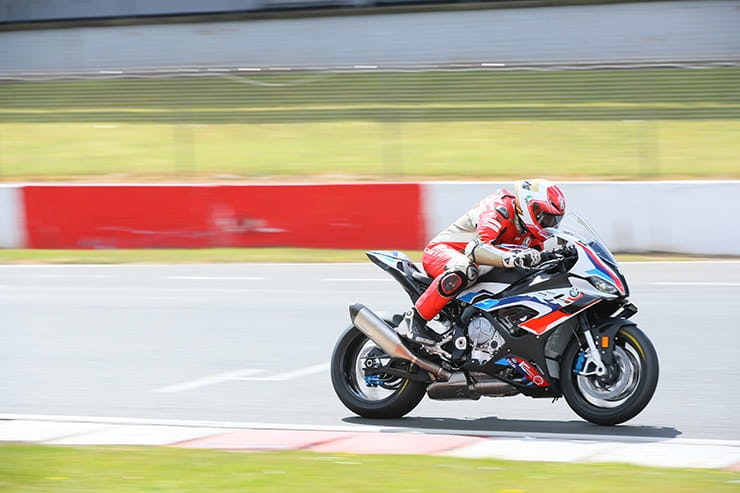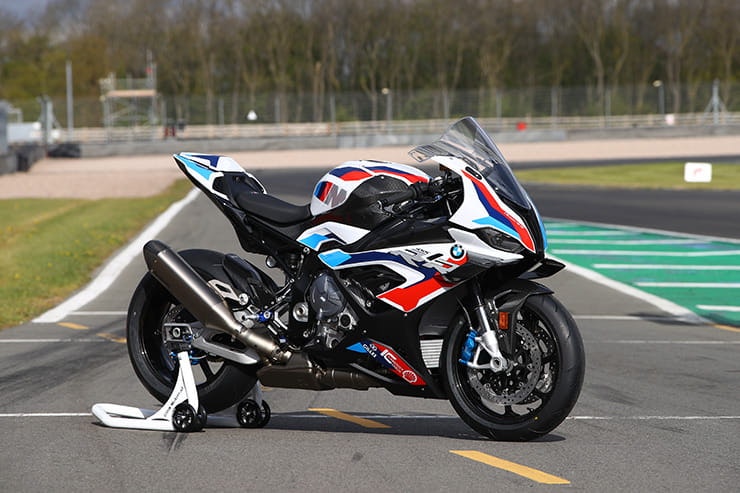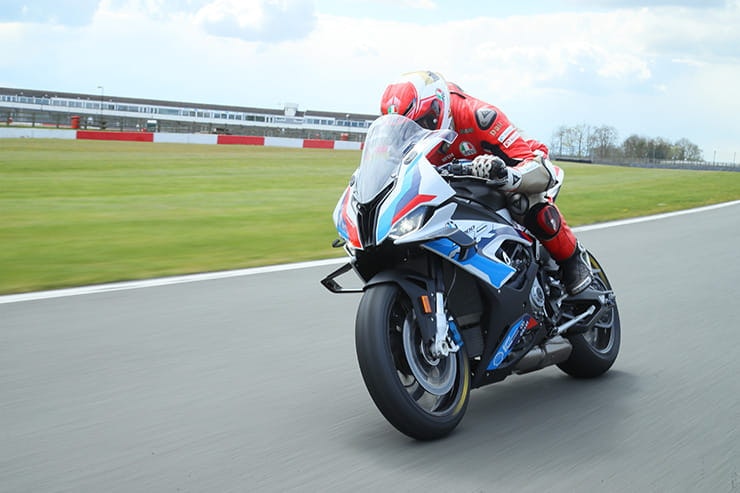BMW M1000RR (2021) - Review
By Michael Mann
BikeSocial Managing Editor
06.05.2021
Kit Credits
Helmet
AGV Pista GP-RR (with custom paint job from LDC Designs), £999.99 | www.agv.co.uk
One-piece Leathers
Dainese D-air Racing Mugello, £2,799.95 | www.dainese.com
(Custom fit and personalised via Dainese Custom Works)
Gloves
Dainese Full Metal 6, £299.95| www.dainese.com
Boots
Dainese Axial D1, £519.95 | www.dainese.com
“M stands for power”, say the BMW marketeers. It’s true too, look at the M cars. They've been offering sacksful more than their non-M equivalents ever since the M1 debuted back in the late 70’s. A quick glance at the BMW car website and there are currently 12 M models listed. How many on the ‘Motorrad’ or ‘motorcycle’ website? One. This one. The new one. The M 1000 RR. And what a looker it is. Decadent in the customary M sport colour scheme and based heavily on the S 1000 RR which his hardly outdated or slow but that 2019 model hasn’t quite cut the mustard in the racing world and that’s hurt the German marque’s pride. It’s been too long since fortune favoured them on the racetrack, well away from the TT and with a certain Mr Hickman at the helm anyway, so now is the time for the sleeves to be rolled up and a homologation special as their way forward.
Designed to meet FIM World Superbike and Superstock regulations, the new M is built around the S 1000 RR with revisions to its 999cc ShiftCam inline four. More power and less weight is the holy grail for manufacturers but add more electronics plus aerodynamic enhancements and a handful of chassis tweaks and the M 1000 RR was born, and with a hearty £30,935 price tag too – still, that is only three Boris Johnson-spec John Lewis sofas. Is this the base model on which the WSB, STK, BSB titles can be fought? What I lack in global racing experience at the highest level, I make up for having ridden every one of its road-worthy rivals. Off to Donington Park for a place on a Focused Events track day we trotted to see how the M measures up.
Sublime and silky power
Array of electronics to personalise the ride
Lightweight handling, like a 600
Price justification vs S100RR M-pack
Standard tyres are very road-biased
Still loves a wheelie – wait, is that a con or a pro?
Come for a ride on the 2021 BMW M 1000 RR
BikeSocial’s Michael Mann offers an in-depth look around the new BMW M 1000 RR and wobbles around Donington Park for a bit
BMW M 1000 RR (2021) Price
How much is the 2021 BMW M 1000 RR? £30,935.
It’s a mighty figure but you’ve got to stump up the cash if you want the goods. And if you’re just using the spec sheets to compare it to the S 1000 RR (with M Pack) then you’ll be hard pushed to justify the 50% price hike. But, when you start considering the work that’s gone into the engine, chassis and electronic upgrades it begins to make sense, and looking around the bike, there’s a strikingly meticulous finish on every component.
If a PCP deal is on the cards, then this is the BMW example:
Power and Torque
I’m not sure about you but talk of peak power figures of more than 200bhp would have had my eyes out on stalks five years ago but now it’s what everyone does, right? As you’d expect with a company famed for its precision, 209.2bhp is still a figure that’ll get your juices flowing but it’s harnessed in such a way that it’s almost pop-to-the-shops regular. Manageable some might say. It’s still fast, very fast in fact, and the high peak power and torque figures of 209.2bhp / 156kW @ 14,500rpm and 83.35ft-lbs / 113Nm @ 11,000rpm respectively, the M 1000 RR is not to be messed with. It’ll bite but will ask nicely before it does. My colleague spoke about the lack of character with vastly powerful inline fours and I understand what he means particularly with the Italian V4s grunting and grumbling their way to 200bhp+ but this example of German engineering sings all the way very quickly past 14,000rpm even though the tune makes you think of shifting up at 8,000rpm.
Acceleration is smooth with a touch of elegance about its outrageous pace. The throttle connection is seamless and even though the peak torque figure matches the S 1000 RR, it seems more eager to pull without the need to change down, i.e. at the Old Hairpin for example, it’ll happily pick up in third or fourth, though short-shifting when accelerating hard from slower corners is one way to keep the nose down, despite wheelie control being involved there’s still a keenness for the front wheel to lift. So much so I found myself climbing over the front of the bike when coming out of the Melbourne Hairpin. New wings and geometry are no match for 209bhp.
Engine, Gearbox and Exhaust
A revised version of the S 1000 RR’s ShiftCam 999cc inline four is now rated at 209bhp, that’s an increase of 5bhp at 1,000rpm higher than before. How? New pistons that are 12g lighter plus longer and lighter titanium conrods that replace the S’s steel versions, slimmer and lighter rocker arms and a higher compressions ratio with that redline up by 600rpm at 15,100rpm. BMW claims greater performance from 6,000rpm verses the S model as well as a 0.4s improvement in acceleration from 0-125mph… and you can certainly tell. It feels racier, livelier and more eager to push the needle towards that redline. Aided certainly by the shorter gearing thanks to the 46-tooth rear sprocket versus the 45T version on the S, and a 3.6kg lighter titanium exhaust system by Akrapovič.
Firing the bike into life when cold sounds a little clattery but once warm and ready for action it’s humming nicely. On the bike, you hear the exhaust pitch reaching a scream as the engine spins way beyond 10,000rpm, though stand by the circuit and the track day machines wearing unbaffled race cans drown the BMW out. Handy for the neighbours when you’re heading out for the Sunday jaunt but disappointingly less ferocious given the sheer pace of the bike when flying down Donington’s start/finish straight. The collector box and full exhaust run is a fine example of how well put together the BMW is. For all the Euro 5 compliance, the full system still looks blooming smart underneath unlike so many others.
Refinements to quick shifting systems on all modern day sportsbike are commendable. Use the clutch to move away from standing and it’s not needed again until you stop. In between then it’s down to the BMW engineers to provide the right equipment to propel or whatever the opposite of propel is. This particular ‘Shift Assist’ technology is among the best on any bike – the lever can be inverted easily for a race shift style approach, but either way around it still slots between the gears quickly and smoothly despite those pistons pinging around at the thick end of 14,000rpm. And with so much torque available there’s no shame to short-shifting to ensure you’re focused on keeping the drive without upsetting the balance.
Does the motor have enough feel though? It’s not a V4 so there’s less mechanically related reward, it’s not vibrating your seat or ear drums. The inline arrangement of the four cylinders and it’s ShiftCam addition is BMW’s way of providing what they believe is the optimal performance, weight, and balance. And in the racing world, the recent BSB test at Snetterton would demonstrate how effective that is. There’s no denying the out-and-out pace of the M RR and it’s (electronically adjustable) engine braking assistance which was endorsed at Donington. Rolling off and clicking down a couple of gears for Turn 1 meant a full grab of brakes wasn’t required and that means the bike retains its balance. It’s not lunging forwards or wagging its tail, leaving you to focus on the apex and feeding the gas on.
BMW M 1000 RR (2021) Comfort and Economy
How comfortable are sportsbikes is a bit like asking how tasty is dog food. If you really need to then you would; eat the Pedigree Chum and ride the bike. That said, with more power comes a greater responsibility to keep handling optimal and that has resulted in a longer wheelbase courtesy of new suspension geometry with a 23.6 degree head angle and 3mm less fork offset. Wheelbase grows from 1441mm to 1457mm in the process, thanks in part to a swingarm that’s 11.7mm longer than the normal version. The swingarm pivot point is also more widely adjustable than on the stock S1000RR. Overall, and despite my 6ft and 14 stone frame appearing to be wedged into the bike in these surrounding photos, I felt the cockpit a roomy place to be, comparatively to other litre class sportsbikes. The screen is higher too allowing for a more aerodynamic feel when tucked in. I’m no Moto3-esque whippet but I didn’t feel too lardy on the M RR, there’s still room to slide back for the straights and a decent fuel tank area to place a knee when cornering.
For road use, home comforts such as cruise control and heated grips offer a degree of tranquillity to this £31k race-oriented missile which is said to return an economy figure of 43.5mpg which in theory offers 150-miles from its 16.5-litre tank. Not at Donington Park though.
Handling, Suspension and Weight
The four-cylinder heart of the M RR are neatly tucked into the unchanged aluminium chassis that’s agile but stable enough to cope with the stresses of all that power. The non-semi active Marzocchi forks and rear shock have been tweaked to suit the rigours of the new bike and, as you can see from the slow-mo video footage, they dealt with Donington’s bumps with real composure, smoothing out most of the nasty bits and certainly keeping the bike on its trajectory. The suspension is just one element that links together with fine chassis and the comparatively very light 192kg ready-to-ride weight forming almost 600 supersports-like handling.
Given the chance to spend a little more time to adjust the M RR to my liking, I think a little more pre-load on the rear would have accentuated a slightly sharper turn-in but really there’s no complaints in how composed the bike is under braking and flip-flopping from side-to-side. Only under hard acceleration from low speed does the front wheel not fully comply – dialling in a little more wheelie control would help of course but that would equally hinder performance.
Aerodynamically, the winglets are such an obvious set of appendages, though they’re bespoke to this set of fairings and not just stuck on. They’re meant to add stability under braking which I can certainly agree with but controlling wheelies I’m less convinced by. Then again, to find the right settings for your style means playing around with the electronics and suspension to suit. The standard OE tyres are Dunlop Sport Smart TT’s which is a little surprising given their road-orientation and the bike’s love for the track. The Dunlop’s wore very well during the five track sessions and for my level of riding which is enough not to be embarrassed in the fast group but nowhere near Superstock level, they held the line well and provided enough grip given how slippery Donington can be – especially after a little drizzle as was the case on this launch.
BMW M 1000 RR (2021) Brakes
Don’t lose sight of the fact BMW built this to compete at the highest levels of production-based motorcycle racing, it’s not gone their way over the last couple of seasons but the M holds the required revisions, so says the German marque. Racers noted braking stability as one of the issues affecting their ability to bring the BMW into race-winning contention, a fact BMW has addressed with not only a set of carbon winglets (large enough to squeeze seven Mr Kipling slices into) but revised Nissin brakes replace the Hayes versions from the S. In fact, the rear brake caliper has moved to the underside of the 220mm disc. The calipers are lighter while the discs thicker than the S.
With the geometry changes, aerodynamic enhancements, brake upgrades and new electronic engine braking adjustability, BMW have certainly gone to town on making sure the M stops quickly, effectively and with no tail wagging or real wheel lift. And that was well tested into the Foggy Esses, two hairpins and Redgate – the four hard braking areas of Donington. I was impressed with both brake lever feel and chassis calmness.
From a maximum speed of 190mph (306kph), they say it takes just 10.7s to stop. Complete with your breakfast now coating the inside of your visor.
Above: you know it’s the ‘Competition Pack’ because of the foot pegs and DLC chain
Rider aids
Ok, where to begin. Seven rider modes include four pre-set versions with Rain, Road, Dynamic and Race then three further customisable modes known as Race Pro 1, 2 and 3 – these allow bespoke settings for engine power, traction control, engine braking, wheelie control and ABS. Everything is controlled and operated via the familiar tracker wheel on the left-side of the switchgear, though a separate ‘Mode’ button can be used to toggle between the seven but that requires a closed throttle to make the switch.
The array of settings available makes this such an adaptable and versatile machine – I won’t say it should solely be used by professional or experienced riders because of the degree of flexibility in the settings – though in reality, while there’s a lot of technology shielding that huge power, it still needs treating with care.
There aren’t many motorcycles equipped with cruise control and a pit lane speed limiter or heated grips and launch control but BMW through it necessary to add their full suite. It also includes, Gearshift Assist Pro, Hill Start Control Pro and Slide Control, all operational via the same very clear and easy-to-navigate 6.5” TFT display.
The rider aids add a protective shroud and the more familiar you become, the more you can dial everything back. Optional extras include an Anti-theft alarm, tinted windshield, tyre warmers, plus the full £4100 M Competition Package which adds M Brake Lever, M Clutch Lever, M Brake Lever Guard, M Rider Footrest, M Engine Protector, Carbon parts, lighter weight swinging arm and a pillion seat cover.
Rivals
Fast and furious development in recent times has seen the performance capabilities way exceed the 200bhp barrier and yet it’s the apparently ‘slowest’ that’s had all the World Superbike success. That said, of course the production bike you or I could buy isn’t exactly what the likes of Rea, Sykes, Redding and co. earn their living on. In a straight fight for lap times, the following four would be the nearest road-legal competition to the new M 1000 RR:
BMW M 1000 RR (2021) Verdict
In those iconic Motorsport colours, it might look like the S 1000 RR from a distance or to the untrained eye but the M is a thoroughbred race machine and BMW have one thing on their mind; winning. Superbike, Endurance and Superstock titles, plus the TT top step are the focus.
With a £10,000 premium on top of the S 1000 RR (inc. the M Package), there’s an awful lot of justification required to encourage me to spend the extra but that’s like saying would you opt for the 330 M or go all in for the M3? Sometimes it’s not about whether you need the performance, it’s about which makes you feel better if they were side by side in your garage.
The M is without doubt a striking machine. It’s super quick, stable and beautifully pieced together, it’ll attract plenty of attention as a road bike – which it certainly could be with its heated grips and cruise control. It’s certainly comfortable enough too for a Sunday fun bike but you won’t fit much shopping in the winglets.
Does it have enough character or soul? It certainly shouts loud enough and with the extra revs, downforce and chassis changes there’s no denying it’ll chew up and spit out most other road-legal superbikes. BMW might be continuing to sell on a Monday without winning on Sunday but this could be the motorcycle to change the race fortunes and perhaps boost showroom footfall.
BMW M 1000 RR (2021) Technical Specification
Photos by James Wright / Double Red
Video by Joe Dick / Full Gas


